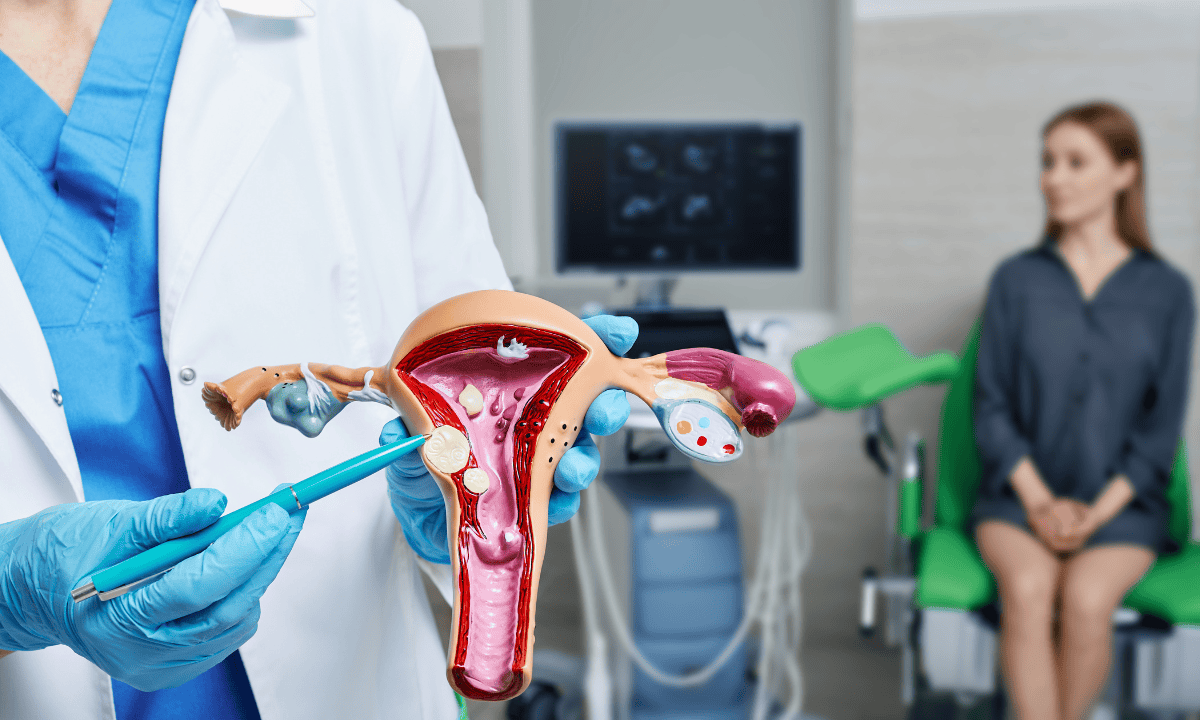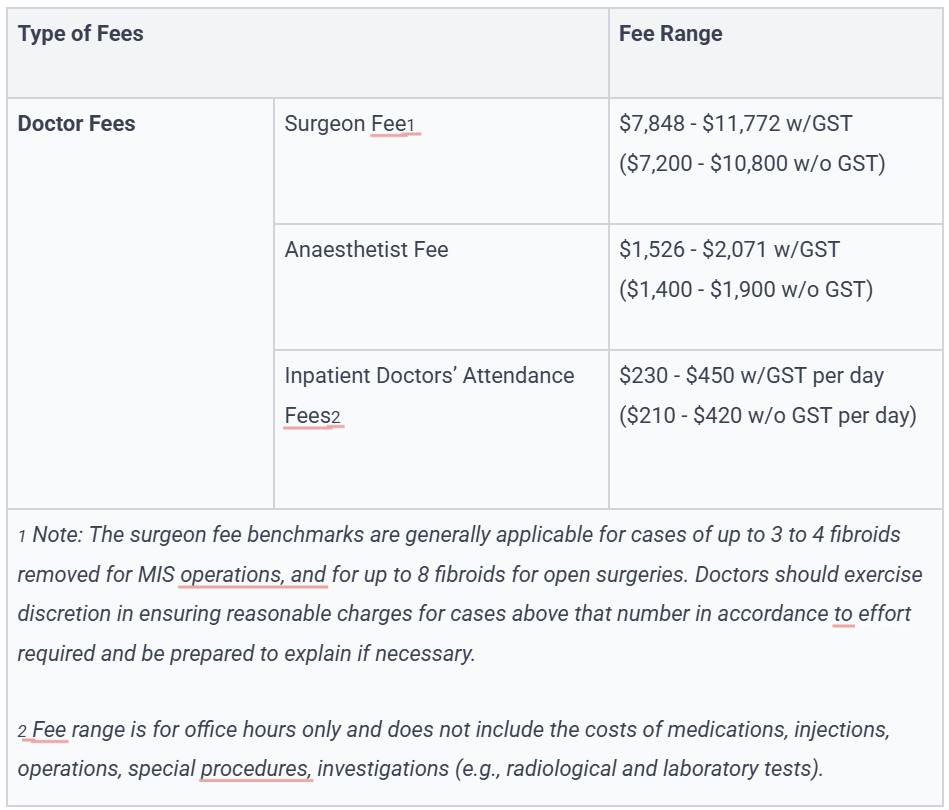What is fibroid removal surgery?
Fibroid removal surgery, also known as ‘myomectomy’, is a surgical procedure done to remove uterine fibroids. Fibroids are common noncancerous growths that develop in the uterus, usually during childbearing years.
Fibroid removal surgery aims to take out fibroids to reduce symptoms such as heavy menstrual bleeding and pelvic pressure. It is different from a hysterectomy, as a hysterectomy removes your entire uterus, whereas a myomectomy only removes the fibroids and leaves your uterus.
When should I get fibroid removal surgery?
Your doctor might recommend surgery for fibroids causing symptoms that are troublesome or interfere with your normal activities. Symptoms include:
Pain or bleeding
Issues with fertility
If you need surgery, reasons to choose a myomectomy instead of a hysterectomy for uterine fibroids include:
You plan to bear children
Your doctor suspects uterine fibroids might be interfering with your fertility
You want to keep your uterus
Disclaimer: The information provided is for general knowledge only and should not be considered a substitute for professional medical advice.If you're experiencing any of these symptoms, request an appointment with our specialists at Thomson Medical for an accurate diagnosis and tailored treatment plan.
What are the three different types of fibroid removal surgeries?

Depending on the size, number, and location of your fibroids, your surgeon may choose one of three surgical approaches to fibroid removal.
Abdominal myomectomy
In abdominal myomectomy (laparotomy), your surgeon makes an open incision on your abdomen to access your uterus and remove fibroids.
Your surgeon will generally prefer to make a low, horizontal ("bikini line") incision, if possible. Vertical incisions are required for larger uteruses.
Laparoscopic or robotic myomectomy
In both laparoscopic and robotic myomectomy, which are minimally invasive procedures, your surgeon accesses and removes fibroids through several small abdominal incisions.
Compared with women who have a laparotomy, women who undergo laparoscopy have less blood loss, shorter hospital stays and recovery periods, and lower rates of complications and developing abnormal tissue connections after surgery.
There are limited comparisons between laparoscopic and robotic myomectomy. Robotic surgery may take longer and be more costly, but otherwise few differences in outcomes are reported.
Laparoscopic myomectomy:
Your surgeon makes a small incision in or near your bellybutton.
Afterwards, they will insert a laparoscope—a narrow tube fitted with a camera—into your abdomen.
Your surgeon performs the surgery with instruments inserted through other small incisions in your abdominal wall.
Robotic myomectomy:
Your surgeon inserts instruments through small incisions similar to those in a laparoscopic myomectomy and then controls movement of the instruments from a separate console.
Some surgeons are now performing single-port (one incision) laparoscopic and robotic myomectomies.
Occasionally, the fibroid is cut into pieces (morcellation) and removed through a small incision in the abdominal wall. Other times, your surgeon makes a larger incision in your abdomen to remove the fibroid without cutting it into pieces. Rarely, the fibroid may be removed through an incision in your vagina (colpotomy).
Hysteroscopic myomectomy
To treat smaller fibroids that bulge significantly into your uterus (submucosal fibroids), your surgeon may suggest a hysteroscopic myomectomy. Your surgeon will access and remove the fibroids using instruments inserted through your vagina and cervix into your uterus.
A hysteroscopic myomectomy generally follows this process:
Your surgeon inserts a small, lighted instrument through your vagina and cervix and into your uterus. They will most commonly use either a wire loop resectoscope to cut the tissue using electricity or a hysteroscopic morcellator to manually cut the fibroid with a blade.
A clear liquid, usually a sterile salt solution, is inserted into your uterus to expand your uterine cavity and allow examination of the uterine walls.
Your surgeon will then shave pieces from the fibroid using the resectoscope or the hysteroscopic morcellator, taking out the pieces from the uterus until the fibroid is completely removed.
Sometimes large fibroids can't be fully removed in one surgery, and a second surgery is needed.
What is the cost of fibroid removal surgery in Singapore?
Costs for fibroid removal surgery in Singapore vary significantly depending on whether you choose a public or private hospital.
Inpatient
At private hospitals, the price ranges from SGD 23,100 to SGD 32,400.
These price ranges generally cover the operation fee and other ad hoc fees as per MOH's SI815U bills and fee benchmark.
MOH provided a breakdown of the fees for private hospitals and clinics:
Breakdown of Fees

However, additional charges may arise from expenses such as pre-surgery consultations, imaging tests like X-rays or CT scans, medications, and post-surgery follow-up appointments.
This article was written in June 2025. Hence, prices for fibroid removal surgery may have changed since then. For more accurate benchmarking prices, please visit the MOH website for more details.
Are there any subsidies for fibroid removal surgery?
Yes, there are several schemes in Singapore that can help offset the total costs of fibroid removal surgery.
These include MediSave, MediShield Life, and Integrated Shield Plans. Each offers different levels of coverage for your fibroid removal surgery, depending on your eligibility and insurance arrangements.
MediSave
MediSave is a national medical savings scheme that allows Singaporean citizens and permanent residents to use their savings for hospitalisation expenses.
For hospitalisation, you can use up to SGD 1,130 per day for the first two days and SGD 400 per day for subsequent days for inpatient hospital charges. These charges include daily ward charges, treatment fees, investigations and medications.
According to the CPF website, fibroid removal surgery is classified under 5A on the Table of Surgical Procedures (TOSP). Hence, the withdrawal limit for fibroid removal surgery is SGD 2,610.
Prices for fibroid removal surgery may change over time. For more accurate benchmarking prices, please visit the CPF website for more details.
MediShield Life
MediShield Life is a basic health insurance plan for all Singaporeans and PRs, designed to help pay for large hospital bills and selected costly outpatient treatments.
It will cover a portion of the surgical and hospitalisation costs for fibroid removal surgery, and similar to MediSave, there are claim limits.
For hospitalisation, the claim limits are SGD 830 per day for normal wards and SGD 5,140 for intensive care unit (ICU) wards, which include an additional SGD 800 per day for the first two inpatient days.
For surgical procedures, MediShield Life also follows the TOSP, meaning that there will be a claim limit for fibroid removal surgery at SGD 2,700.
Prices for fibroid removal surgery may change over time. For more accurate benchmarking prices, please visit the CPF website for more details.
Integrated Shield Plans
Integrated Shield Plans (IPs) are private insurance policies that offer additional coverage beyond what is provided by MediShield Life. They can cover a larger portion of your hospital bill, especially if you opt for private hospitals or higher-class wards.
Many IPs also offer “as-charged” benefits, meaning they cover the actual bill amount, subject to policy terms and annual limits.
Coverage details and claim limits vary depending on the insurer and the specific plan and additional riders purchased.
If you are curious how much you can claim from your IPs for your fibroid removal surgery, it is best to talk to your insurance provider directly to discuss the details of your plan. For those under Prudential, please contact us via the Prudential medical concierge form if you have any further questions.
What factors affect the cost of my fibroid removal surgery?
Several key factors influence the final bill for fibroid removal surgery in Singapore:
Pre-surgery expenses
Initial consultation fees
Diagnostic imaging tests
Pre-operative assessments
Specialist referrals
Surgery-related costs
Surgical fees and anaesthesia
Type of surgery
Public hospital vs private hospital
Size and location of fibroid
Post-surgery expenses
Follow-up consultations
Gynaecologists at Thomson Medical
Loading...
Case Study: Private Hospital with Integrated Shield Plan
Profile: A 35-year-old with multiple fibroids (largest 9 cm) requiring open abdominal myomectomy with a 3-day hospital stay at a private hospital.
| Estimated total bill | Insurance coverage | Final out-of-pocket expenses |
|---|---|---|
| SGD 23,076 to SGD 32,362 | Since 2019, the Ministry of Health (MOH) has mandated that all new IP riders include a minimum 5% co-payment—to encourage prudent use of healthcare services and avoid overconsumption. | The patient would need to pay from SGD 1,154 to SGD 1,618, which can usually be covered by MediSave. |
Please note that for the most accurate estimate of insurance coverage and out-of-pocket expenses, you should consult their insurance provider directly, as coverage details vary by plan and insurer.
*This article was written in June 2025. Prices may have changed since then. For more accurate benchmarking prices, please visit the MOH website for more details.
How do I process my insurance claims?
To process an insurance claim at a hospital in Singapore, you typically need to inform the hospital staff of your intent to claim, gather required documents like final bills and receipts, and submit the claim to your insurance provider through their designated channels (online portal, email, etc.).
For some insurance policies, the hospital may handle the claims process directly, especially for cashless claims. Here's a more detailed breakdown:
Understand your coverage:
Before you schedule your treatment, meet your financial advisor to discuss the costs and coverage available for you should you undergo fibroid removal surgery.
Inform the hospital:
When you are admitted to the hospital, inform the hospital staff that you wish to make an insurance claim. They may guide you through the necessary paperwork and forms.
Gather the required documents:
Ensure you have all the original, final bills and receipts for all treatments, including hospital stays, procedures, and medications.
If available, gather any relevant medical reports, diagnostic test results, and discharge summaries.
If you used your MediSave account for payment, you'll need a statement showing the Hospital Registration Number (HRN).
You may need to download and complete a claim form from your insurance provider's website.
Submit the claim:
Many insurers offer different portals for submitting claims, including online portals, mobile apps, email, or direct paper submission to your financial advisor.
If the hospital handles the claim directly, they will submit it on your behalf.
Follow up and track progress:
You should receive an acknowledgement of your claim submission.
Check the status of your claim through your insurer's online portal or app.
Do note that claim processing typically takes about 2 to 3 months from the date of submission (e-filing).
Some complex cases may take longer, especially if additional documents or clarifications are required.
If you don't receive updates after 3 months or have more questions, contact your insurer or the hospital for assistance.
At Thomson Medical, the insurance claims process is streamlined for your convenience. The hospital provides e-filing services, submitting claims directly to MediSave, MediShield Life, and Integrated Shield Plan providers on your behalf. This approach reduces paperwork and ensures claims are processed efficiently, allowing you to focus on recovery.
Please note that insurance panel coverage may vary by doctor. To confirm whether your preferred doctor is on your insurance panel and check your eligibility, schedule an appointment with the doctor directly. If you require further information about insurance availability or claims processing, contact our medical concierge for assistance.
FAQ
How much does fibroid surgery cost in Singapore?
For inpatient stays, the price range at public hospitals will be from SGD 3,000 to SGD 16,300, depending on the ward you choose to stay in. At private hospitals, the price ranges from SGD 23,100 to SGD 32,400. This article was written in June 2025. Hence, prices for fibroid removal surgery may have changed since then. For more accurate benchmarking prices, please visit the MOH website for more details.
Is myomectomy more painful than a C-section?
Recovering from a myomectomy that was performed laparoscopically or vaginally would not be as painful as a C-section, but the pain following an open abdominal myomectomy vs. C-section would be more comparable but not entirely the same.
Is a myomectomy a major surgery?
Abdominal myomectomy is a major surgical procedure that requires general anaesthesia and up to a two-night stay in a hospital. Following the procedure, you may experience mild cramps, pain and light vaginal bleeding for up to several weeks.
Why is myomectomy not recommended?
Risks of myomectomy include excessive blood loss. Many women with uterine leiomyomas already have low blood counts (anaemia) due to heavy menstrual bleeding, so they're at a higher risk of problems due to blood loss.
What size fibroids need surgery?
Doctors might recommend removing fibroids larger than 5-6 cm (about 2-2.4 inches), especially if they are affecting your fertility, rapidly growing, or causing symptoms. Persistent or worsening symptoms also indicate that your fibroid has grown and may need to be removed.
How is the first period after myomectomy?
You may have a brown or reddish-brown vaginal discharge or light vaginal bleeding or spotting for a few weeks. This is normal. Expect your first two periods to start early or late. They may be more painful or heavy than usual.
Disclaimer: The information provided is intended for general guidance only and should not be considered medical advice. For personalised recommendations and tailored advice on pricing and services, contact us at Thomson Medical today.
For more information, contact us:
Thomson Medical Concierge
- 8.30am - 5.30pm
- WhatsApp: 9147 2051
Need help finding the right specialist or booking for a group?
Our Medical Concierge is here to help you. Simply fill in our form, and we'll check and connect you with the right specialist promptly.
Notice:
The range of services may vary between Thomson clinic locations. Please contact your preferred branch directly to enquire about the current availability.
Get In Touch
